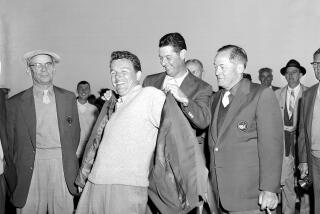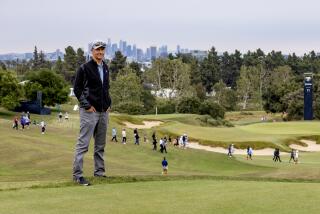Hades of Hulton Road : Oakmont Offers a Test of the Three Pâs: Patience, Preciseness and Persistence
OAKMONT, Pa. â Maybe time and tradition have dulled it down and dressed it up, stripped it of the unforgiving river-sand furrowed bunkers and whitewashed away some of its character and cantankerousness.
Be assured, however, that Oakmont Country Club--nine decades old and proud, an unrelenting 6,946-yard, 4 1/2-hour test of patience, preciseness and persistence--remains one hellish lady of a golf course.
They donât call it the Hades of Hulton Road for nothing, and it will be called plenty more names, many of them unmentionable, by the time the U.S. Open concludes next Sunday. History says so.
âThe course is sensational,â former British Open champion Ian Baker-Finch said. âEvery green is different and has its own feel to it. It will be good to go back there.â
His sentiments arenât shared by all.
Itâs been 11 years since the U.S. Open last visited Oakmont, since the worldâs best golfers battled through its unfathomable rough and slick greens and two lightning storms only to be brought to their knees again by a one-of-a-kind monument of America golf, a National Historical Landmark whose stubborn personality has never been altered by mere physical changes.
Nestled unpretentiously in an unruffled but hardly tiny residential community a dozen miles from Pittsburgh, alongside a restored red-brick main street and prettied up by a half-million dollars worth of trees and flowers, Oakmont looks deceptively tranquil, peaceful and unchallenging. Until the first tee.
Trouble, and history, await around every corner, lie in each of its 165 sandpit fairway and greenside bunkers, threaten on skittish greens so fast the Stimpmeter was designed just to measure them. Great golfers have won great championships here, but many more have been lost--just ask Sam Snead, or Arnold Palmer, or Tom Watson.
The legend of Jack Nicklaus began here at age 22 in 1962, when he survived an 18-hole playoff to conquer King Arnie in Palmerâs own western Pennsylvania playpen and win his first major championship. Nicklaus had turned pro only seven months before and certainly wasnât the crowd favorite, not here in Arnie Country. Golf would never be the same.
âIâm sorry to say that heâll be around for a long time,â a disappointed but prescient Palmer said afterward.
Theyâll both be around for the Open this time, Arnie and Jack, playing partners in a specially arranged practice round Tuesday that will unleash an Arnieâs Army-sized contingent of fans upon Oakmontâs lushness. Palmer hasnât played in an Open in 10 years, but the USGA wasnât about to deny him an exemption for this homecoming.
In 1973, aided by a soggy course that drained the meanness from Oakmontâs greens, Johnny Miller won the Open with an historic final-round 63, maybe the greatest round of championship golf ever played.
Twenty years before, Ben Hogan continued his greatest season--he also won the 1953 Masters and British Open--by beating runner-up Snead by six strokes. Hoganâs par-birdie-birdie, 3-3-3 finish remains the stuff of legend.
Oakmont, of course, wasnât always that easy. Hardly. Tommy Armour couldnât even break 300 while winning in 1927, defeating Harry Cooper in a playoff after they had tied at 301. Cooper would have won in regulation if he hadnât putted off the 17th green and into a bunker during an early round.
Sam Parks won in 1935 by shooting a 299 to defeat Jimmy Thomson by two strokes, and, fittingly enough, later became a U.S. Steel executive and one of Oakmontâs 250 members. The USGA president that year was Prescott Bush, whose son, George, became better known for his baseball than his golf--and for becoming the 41st president of the United States.
Watson couldnât hold his final-round lead, or hold off Larry Nelson, in 1983. Nelson barely made the cut, then fired a 65-67 finish to edge Watson in a rain-delayed tournament that wasnât completed until Monday morning, before only a few thousand spectators and hours before the tape-delayed ending was shown on national TV.
Oakmont has been modernized, and demystified, since its founding in 1903--50 members quit when its first swimming pool was built in 1954, and many more retain grudges against the USGA for ordering the furrowed bunkers to be made less intimidating in 1953, for the 5-inch rough to be shortened in 1983. Once barren of water or trees, Oakmont now has as many trees as any premier U.S. course.
And while Oakmontâs members still include the wealthy corporate executives, thereâs also a familiar name or two such as Penguins star Mario Lemieux, whose $42 million contract allows him to easily afford Oakmontâs $30,000 initiation fee and $220-a-month dues.
But Oakmont is still Oakmont, a testament to its founder, steel magnate Henry C. Fownes, who purchased a 191-acre farmland tract just after the turn of the century and built one of the worldâs greatest golf courses atop its rough, rock-strewn turf.
Fownesâ son, William C., the 1915 U.S. Amateur champion, took on Oakmont as his personal cause, made it even tougher, built row upon row of sandpit bunkers with their 3-foot-high ridges of grass, tightened its 26-yard-wide fairways, made sure that any mistake or foolish boldness was severely penalized.
âA shot poorly played should be a shot irrevocably lost,â was Fownesâ philosophy. There wasnât a drop of lake or stream water on the course and still isnât, but a Saraha-like 3,900-square yard sandpit guards the 253-yard eighth hole and an ominous 95-yard Church Pew bunker protects the historic 15th, with its green so big that 180-foot putts are possible.
So frustrated by these greens, a disheartened Chick Evans resorted to using the handle of his umbrella to hole out on the 14th after failing three times with his putter during the 1919 U.S. Amateur.
A decade after Oakmontâs opening, a banquet speaker recited this oft-recalled rhyme:
Bill Fownes stood by a green one day When someone holed in four. âIâll put a stop to that,â said he. âIâll build two bunkers more.â
He built them, all right. He also built a legend.
More to Read
Go beyond the scoreboard
Get the latest on L.A.'s teams in the daily Sports Report newsletter.
You may occasionally receive promotional content from the Los Angeles Times.










